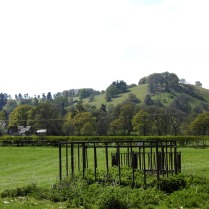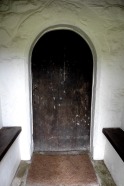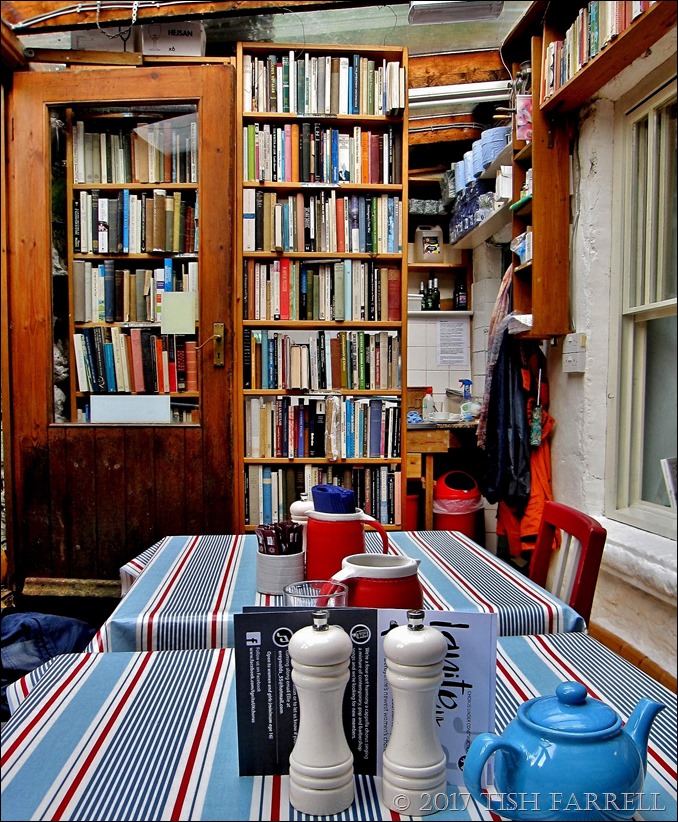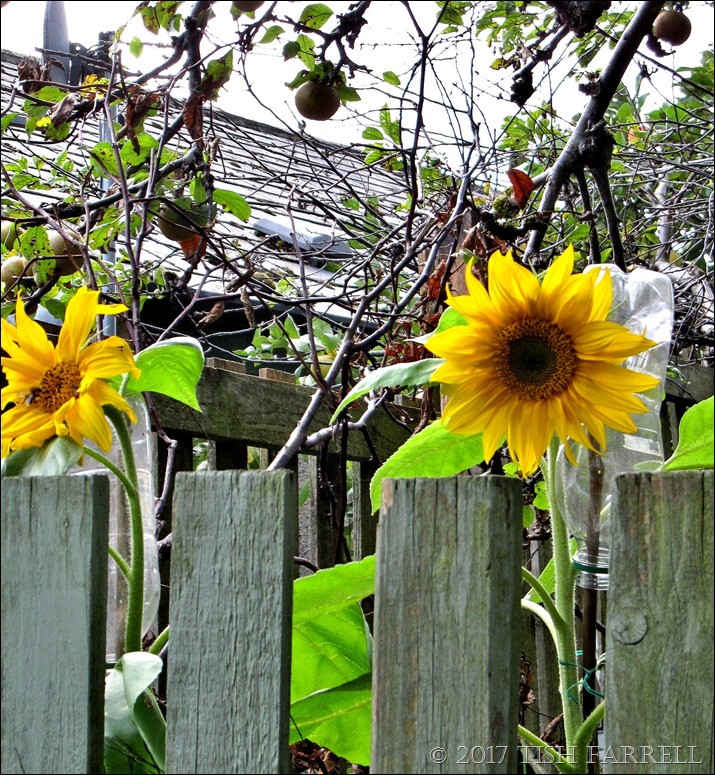Okay. Hands up those of you who know about sin eaters. I certainly had not registered their existence despite having read Mary Webb’s Shropshire novel Precious Bane (1924) which includes a sin-eating scene. It was coming across an article by environmental scientist, Harriet Carty, (also Shropshire based) that alerted me. She was describing the work of the non-religious charity Caring For God’s Acre which has set itself the task of recording Britain’s churchyard flora. I read it back in March when we were in Pembrokeshire and it prompted me to do a post featuring the fine show of lichen in St. Bride’s graveyard. Helen Carty’s article also mentioned the grave of the last sin eater, one Richard Munslow, who died in 1906 and is buried in St. Margaret’s churchyard, Ratlinghope (pronounced Ratchup), up in the Shropshire hills between the Long Mynd and the Stiperstones.
What could be more curious and curiosity-inducing than the grave of a sin eater. Clearly an expedition was called for. Ratlinghope is only twenty miles or so from Wenlock, and so last Thursday, after doing the shopping in Church Stretton and with the weather set fair, we headed for the hills.
That Ratlinghope is an out-of-the-way place is an understatement. The lane from the busy Shrewsbury-Ludlow highway at Leebotwood is mostly single track, and wends up and over the northerly spur of the Long Mynd. If you stop and look behind you, all of the Shropshire and Cheshire Plains spread out below you. On Thursday, though, it was rather hazy, but you’ll get the general idea.

Now for sin eaters. The first thing to know is that the sin-eating custom that once featured at funerals appears to be both ancient and confined mostly to the Shropshire, Hereford and Welsh Marches region. In the extract below, Mary Webb, suggests the sin eaters could be wise men, exorcists, or poor people somehow outcast by misfortune. At a burial, the last meal of the corpse – usually bread and ale – would be passed over the coffin for the sin eater to eat. Through this act, he took on the sins of the deceased thereby ensuring that the departing spirit went in peace. In latter times, it is said, the poor took on the role willingly in order to have a decent meal.
But this was not the case for Richard Munslow of Ratlinghope. He came from generations of respectable farming folk and had his own farm at nearby Upper Darnford where he employed at least two labourers. He also enjoyed the sheep grazing rights on the Long Mynd. The style of his memorial certainly indicates a man of substance. He in fact revived the sin eating custom of his own volition. It is thought that he was inspired to do this through personal loss and an elevated sense of compassion. The gravestone also provides the clue. In 1862 Richard and Ann Munslow lost their first child George aged 11 weeks. Then in the first week of May 1870 they lost all three of their children to scarlet fever. Later, though, there were two daughters who did outlive them. Richard died in 1906 aged 73. Ann lived on until 1913.
The little church itself has its origins some time before 1209 when an Augustinian cell for a prior and seven brethren was established at Ratlinghope. It was an outpost of Wigmore Abbey in north Herefordshire. After the Dissolution of the Monasteries it continued life as the parish church. There are few signs of the original building beyond the foundations, and the church you see to day is the product of successive rounds of renovation. The oak front door, though, has the date 1625 carved on it – a gift of the then church wardens. It is a peaceful place for the last sin eater to take his rest, even if there was no one to perform like offices on his behalf.
Next: sin-eating as described in Precious Bane.
Mary Webb was born at Leighton, near Much Wenlock in 1881, and spent her teen years in the town. She also knew the communities of the South Shropshire Hills and was well versed in their folklore and local vernaculars. It is probable she was familiar with the sin eating of Richard Munslow, hence the passage in Precious Bane, though she gives the performing of the rite her own narrative twist.
I’m posting the whole extract here, not only because it paints a picture of past Shropshire life, but because it includes some fine writing by this often under-valued author. The novel is set in the early 1800s and the narrator is young Prue Sarn, a sensitive and good-hearted farmer’s daughter, who believes no one will ever marry her because of her hare lip. Her older brother, Gideon, is a hard-nosed go-getter who thinks only of making money. At this point in the story Prue’s father has just died.
***
It was a still, dewy summer night when we buried Father. In our time there was still a custom round about Sarn to bury people at night. In our family it had been done for hundreds of years. I was busy all day decking the waggon with yew and the white flowering laurel, that has such a heavy, sweet smell. I pulled all the white roses and a tuthree pinks that were in blow, and made up with daisies out of the hay grass. While I pulled them, I thought how angered Father would have been to see me there, trampling it, and I could scarcely help looking round now and again to see if he was coming.
After we’d milked, Gideon went for the beasts, and I put black streamers round their necks, and tied yew boughs to their horns. It had to be done carefully, for they were the Longhorn breed, and if you angered them, they’d hike you to death in a minute. The miller was one bearer, and Mister Callard, of Callard’s Dingle, who farmed all the land between Sarn and Plash, was another. Then there were our two uncles from beyond the mountains. Gideon, being chief mourner, had a tall hat with black streamers and black gloves and a twisted black stick with streamers on it.
They took a long while getting the coffin out, for the doors were very narrow and it was a big, heavy coffin. It had always been the same at all the Sarn funerals, yet nobody ever seemed to think of making the doors bigger. Sexton went first with his hat off and a great torch in his hand. Then came the cart, with Miller’s lad and another to lead the beasts. The waggon was mounded up with leaves and branches, and they all said it was a credit to me. But I could only mind how poor Father was used to tell me to take away all those nasty weeds out of the house. And now we were taking him away, jolting over the stones, from the place where he was maister.
I was all of a puzzle with it. It did seem so unkind, and disrespectful as well, leaving the poor soul all by his lonesome at the other end of the mere. I was glad it was sweet June weather, and not dark. We were bound to go the long way round, the other being only a foot road. When we were come out of the fold-yard, past the mixen, and were in the road, we took our places—Gideon behind the coffin by him- self, then Mother and me in our black poke bonnets and shawls, with Prayer Books and branches of rosemary in our hands. Uncles and Miller and Mister Callard came next, all with torches and boughs of rosemary.
It was a good road, and smoother than most—the road to Lullingford. Parson used to say it was made by folk who lived in the days when the Redeemer lived. Romans, the name was. They could make roads right well, whatever their name was. It went along above the water, close by the lake; and as we walked solemnly onwards, I looked into the water and saw us there. It was a dim picture, for the only light there was came from the waning, clouded moon, and from the torches. But you could see, in the dark water, something stirring, and gleams and flashes, and when the moon came clear we had our shapes, like the shadows of fish gliding in the deep. There was a great heap of black, that was the waggon, and the oxen were like clouds moving far down, and the torches were flung into the water as if we wanted to dout them.
All the time, as we went, we could hear the bells ringing the corpse home. They sounded very strange over the water in the waste of night, and the echoes sounded yet stranger. Once a white owl came by, like a blown feather for lightness and softness. Mother said it was Father’s spirit looking for its body. There was no sound but the bells and the creaking of the wheels, till Parson’s pony, grazing in the glebe, saw the dim shapes of the oxen a long way off, and whinnied, not knowing, I suppose, but what they were ponies too, and being glad to think, in the lonesome- ness of the night, of others like herself nearby.
At last the creaking stopped at the lych-gate. They took out the coffin, resting it on trestles, and in the midst of the heavy breathing of the bearers came the promising words— “I am the resurrection and the life.” They were like quiet rain after drought. Only I began to wonder, how should we come again in the resurrection? Should we come clear, or dim, like in the water? Would Father come in a fit of anger, as he’d died, or as a little boy running to Grandma with a bunch of primmyroses? Would Mother smile the same smile, or would she have found a light in the dark passage? Should I still be fast in a body I’d no mind for, or would they give us leave to weave ourselves bodies to our own liking out of the spinnings of our souls?
The coffin was moved to another trestle, by the graveside, and a white cloth put over it. Our best tablecloth, it was. On the cloth stood the big pewter tankard full of elderberry wine. It was the only thing Mother could provide, and it was by good fortune that she had plenty of it, enough for the funeral feast and all, since there had been such a power of elderberries the year afore. It looked strange in the doubtful moonlight, standing there on the coffin, when we were used to see it on the table, with the colour of the Christmas Brand reflected in it.
Parson came forrard and took it up, saying— “I drink to the peace of him that’s gone.” Then everybody came in turn, and drank good health to Father’s spirit. At the coffin foot was our little pewter measure full of wine, and a crust of bread with it, but nobody touched them. Then Sexton stepped forrard and said— “Be there a Sin Eater?” And Mother cried out— “Alas no! Woe’s me! There is no Sin Eater for poor Sarn. Gideon gainsayed it.”
Now it was still the custom at that time, in our part of the country, to give a fee to some poor man after a death, and then he would take bread and wine handed to him across the coffin, and eat and drink, saying—I give easement and rest now to thee, dear man, that ye walk not over the fields nor down the byways. And for thy peace I pawn my own soul. And with a calm and grievous look he would go to his own place.
Mostly, my Grandad used to say, Sin Eaters were such as had been Wise Men or layers of spirits, and had fallen on evil days. Or they were poor folk that had come, through some dark deed, out of the kindly life of men, and with whom none would trade, whose only food might oftentimes be the bread and wine that had crossed the coffin. In our time there were none left around Sarn. They had nearly died out, and they had to be sent for to the mountains. It was a long way to send, and they asked a big price, instead of doing it for nothing as in the old days.
So Gideon said— “We’ll save the money. What good would the man do?” But Mother cried and moaned all night after. And when the Sexton said “Be there a Sin Eater?” she cried again very pitifully, because Father had died in his wrath, with all his sins upon him, and besides, he had died in his boots, which is a very unket thing and bodes no good. So she thought he had great need of a Sin Eater, and she would not be comforted. Then a strange, heart-shaking thing came to pass. Gideon stepped up to the coffin and said— “There is a Sin Eater.”
“Who then? I see none,” said Sexton.
“I ool be the Sin Eater.” He took up the little pewter measure full of darkness, and he looked at Mother.
“Oot turn over the farm and all to me if I be the Sin Eater, Mother?” he said.
“No, no! Sin Eaters be accurst!”
“What harm, to drink a sup of your own wine and chumble a crust of your own bread? But if you dunna care, let be. He can go with the sin on him.”
“No, no! Leave un go free, Gideon! Let un rest, poor soul! You be in life and young, but he’m cold and helpless, in the power of Satan. He went with all his sins upon him, in his boots, poor soul! If there’s none else to help, let his own lad take pity.”
“And you’ll give me the farm, Mother?” “
Yes, yes, my dear! What be the farm to me? You can take all, and welcome.” Then Gideon drank the wine all of a gulp, and swallowed the crust. There was no sound in all the place but the sound of his teeth biting it up. Then he put his hand on the coffin, standing up tall in the high black hat, with a gleaming pale face, and he said—
“I give easement and rest now to thee, dear man. Come not down the lanes nor in our meadows. And for thy peace I pawn my own soul. Amen.”
There was a sigh from everybody then, like the wind in dry bents. Even the oxen by the gate, it seemed to me, sighed as they chewed the cud. But when Gideon said, “Come not down the lanes nor in our meadows,” I thought he said it like somebody warning off a trespasser. Now it was time to throw the rosemary into the grave. Then they lowered the coffin in, and all threw their burning torches down upon it, and douted them.
The full Hathi Trust novel text is HERE











































![51CM9EJQ5QL[1] 51CM9EJQ5QL[1]](https://tishfarrell.files.wordpress.com/2014/09/51cm9ejq5ql1_thumb.jpg?w=380&h=550)
![gonetoearth17[1] gonetoearth17[1]](https://tishfarrell.files.wordpress.com/2014/09/gonetoearth171_thumb.jpg?w=348&h=482)
![MuchWenlock05[1] MuchWenlock05[1]](https://tishfarrell.files.wordpress.com/2014/09/muchwenlock051_thumb.jpg?w=642&h=480)
![MuchWenlock10[1] MuchWenlock10[1]](https://tishfarrell.files.wordpress.com/2014/09/muchwenlock101_thumb.jpg?w=641&h=499)

![feat1[1] feat1[1]](https://tishfarrell.files.wordpress.com/2014/09/feat11_thumb.jpg?w=556&h=403)

![feat4[1] feat4[1]](https://tishfarrell.files.wordpress.com/2014/09/feat41_thumb.jpg?w=344&h=482)
![images-3[1] images-3[1]](https://tishfarrell.files.wordpress.com/2014/09/images-31_thumb.jpg?w=223&h=226)
